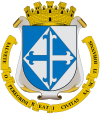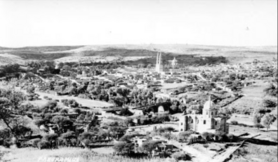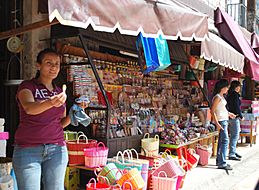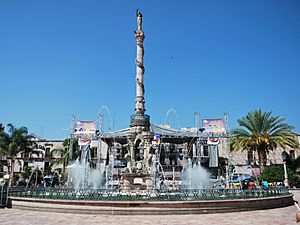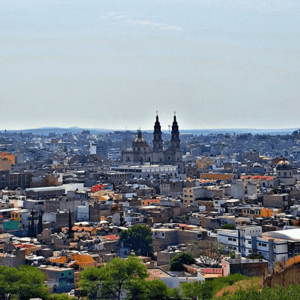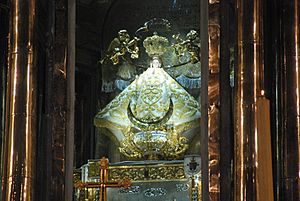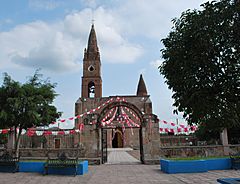San Juan de los Lagos facts for kids
Quick facts for kids
San Juan de los Lagos
|
||
|---|---|---|
|
Municipality and City
|
||
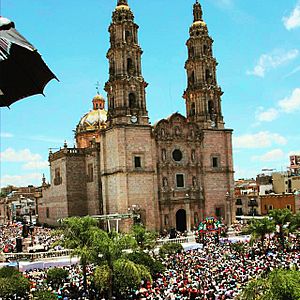
Basilica of San Juan de los Lagos
|
||
|
||
| Nickname(s):
San Juan
|
||
| Motto(s):
Bienvenidos Peregrinos de Paz
|
||
| Country | ||
| State | Jalisco | |
| Area | ||
| • Municipality | 847.7 km2 (327.3 sq mi) | |
| • City | 11.77 km2 (4.54 sq mi) | |
| Population
(2020 census)
|
||
| • Municipality | 72,230 | |
| • Density | 85.207/km2 (220.685/sq mi) | |
| • City | 53,539 | |
| • City density | 4,548.8/km2 (11,781/sq mi) | |
| Time zone | UTC−6 (Central Standard Time) | |
| • Summer (DST) | UTC−5 (Central Daylight Time) | |
San Juan de los Lagos is a city and a municipality in the state of Jalisco, Mexico. It is located in a region called Los Altos. The city is famous for a small statue of the Virgin Mary, known as Our Lady of San Juan de los Lagos. Many people believe this statue can perform miracles. Since 1632, many miracles have been linked to her. This has made the Basilica of San Juan de los Lagos a very popular place to visit. Between seven and nine million visitors come each year. The city's economy depends a lot on these visitors.
Contents
History of San Juan de los Lagos
Early Times
Long ago, before the Spanish arrived, the Los Altos area was home to groups like the Tecuexes and Nahuas. They had small, independent states. Later, a Tecuexe state took over, with its main city at Metzquititlán.
How the City Started
The first Spanish explorer in this area was Pedro Almíndez Chirino. Later, Cristóbal de Oñate took control for Spain. In 1542, people from a village called San Gaspar moved here. They started a new village named San Juan Bautista de Mezquititlán.
By the late 1500s, the town was still very small. It had a few houses and a tiny church. This church held a small statue of the Virgin Mary. It was brought from Michoacán. Over time, the statue got damaged and was put away.
In 1632, something amazing happened. The statue became linked to its first miracle. After this, the statue was fixed and brought back to San Juan. People started coming to see the miraculous statue. Their gifts helped build bigger and better churches for it. The first chapel for the statue was built in 1638. It is now called the Chapel of the First Miracle.
Around this time, more Spanish and mixed-race people moved to the area. Many came from Santa María de los Lagos. Because of this, San Juan Bautista changed its name to San Juan de los Lagos. The number of native people in the city then became much smaller.
Growing and Developing
During the time of Spanish rule, San Juan became more important. This was because of the miracles linked to the Virgin Mary statue. Many visitors came, which helped the city grow. An annual fair started, happening around the time of Candlemas. This fair brought in even more money and people.
San Juan had some special advantages. It was one of the few important religious sites in northern Mexico. Also, it was located where many important roads met. These roads connected mining and farming areas. It was a crossroads for routes linking cities like Tampico, San Luis Potosí, and Zacatecas. It also connected Mexico City and Santa Fé. This made it easy for people to reach the town. The annual fair grew, bringing merchants from many parts of central Mexico.
The fair kept growing in the 1600s and 1700s. The king of Spain officially recognized it in 1797. However, during the early 1800s, the fair was stopped. The area's economic importance then went down.
From Independence to Today
In 1824, San Juan became its own municipality. It was recognized as a city again in 1869.
Between 1926 and 1929, there were conflicts in the San Juan area during the Cristero War.
In 1972, the Catholic diocese of San Juan was created.
The city's current official seal was approved in 1987. It was designed by Gabriel Camarena Gutiérrez de Laris.
In 1990, Pope John Paul II visited San Juan. He came to see Our Lady of San Juan de los Lagos. He led a large mass for about six million people.
Geography of San Juan de los Lagos
Climate
| Climate data for San Juan de los Lagos (1951–2010) | |||||||||||||
|---|---|---|---|---|---|---|---|---|---|---|---|---|---|
| Month | Jan | Feb | Mar | Apr | May | Jun | Jul | Aug | Sep | Oct | Nov | Dec | Year |
| Record high °C (°F) | 37.0 (98.6) |
36.0 (96.8) |
38.0 (100.4) |
39.0 (102.2) |
45.0 (113.0) |
42.0 (107.6) |
38.0 (100.4) |
40.0 (104.0) |
39.0 (102.2) |
40.0 (104.0) |
37.0 (98.6) |
36.8 (98.2) |
45.0 (113.0) |
| Mean daily maximum °C (°F) | 23.7 (74.7) |
25.5 (77.9) |
28.1 (82.6) |
30.4 (86.7) |
31.8 (89.2) |
30.7 (87.3) |
28.0 (82.4) |
28.1 (82.6) |
27.7 (81.9) |
27.3 (81.1) |
26.1 (79.0) |
24.0 (75.2) |
27.6 (81.7) |
| Daily mean °C (°F) | 13.5 (56.3) |
14.7 (58.5) |
17.3 (63.1) |
19.9 (67.8) |
22.2 (72.0) |
22.6 (72.7) |
20.9 (69.6) |
20.7 (69.3) |
20.2 (68.4) |
18.4 (65.1) |
15.8 (60.4) |
14.0 (57.2) |
18.4 (65.0) |
| Mean daily minimum °C (°F) | 3.3 (37.9) |
3.8 (38.8) |
6.6 (43.9) |
9.4 (48.9) |
12.7 (54.9) |
14.6 (58.3) |
13.7 (56.7) |
13.3 (55.9) |
12.7 (54.9) |
9.6 (49.3) |
5.6 (42.1) |
3.9 (39.0) |
9.1 (48.4) |
| Record low °C (°F) | −8.0 (17.6) |
−5.0 (23.0) |
−5.0 (23.0) |
−0.5 (31.1) |
6.0 (42.8) |
4.3 (39.7) |
9.0 (48.2) |
8.2 (46.8) |
0.5 (32.9) |
0.0 (32.0) |
−4.5 (23.9) |
−5.0 (23.0) |
−8.0 (17.6) |
| Average precipitation mm (inches) | 12.3 (0.48) |
6.7 (0.26) |
5.7 (0.22) |
7.7 (0.30) |
23.6 (0.93) |
126.5 (4.98) |
183.3 (7.22) |
175.4 (6.91) |
128.2 (5.05) |
45.1 (1.78) |
11.3 (0.44) |
11.5 (0.45) |
737.3 (29.02) |
| Average precipitation days (≥ 0.1 mm) | 1.8 | 1.0 | 1.1 | 1.3 | 3.6 | 11.8 | 17.1 | 16.8 | 11.4 | 5.3 | 1.6 | 1.9 | 74.7 |
| Source: Servicio Meteorológico Nacional | |||||||||||||
San Juan de los Lagos has a fairly dry and warm climate. Winters are mild. The average temperature each year is about 19.1 degrees Celsius (66.4 degrees Fahrenheit). It gets below freezing about 19 days a year. Most of the rain falls in the summer months.
Land and Rivers
The city is in Jalisco state, about two hours northeast of Guadalajara. It is part of the Los Altos region. The municipality covers about 874 square kilometers. It shares borders with several other municipalities.
The area is mostly flat land or gentle hills. The lowest point is the San Juan River. The highest points are the Lozano and Los Indios mesas.
The area is part of a large river system. The main rivers are San Juan (Lagos) and El Agostadero. There are also three dams: Peña de León, Los Laureles, and Alcalá. Many smaller streams flow through the area. There are also fresh water springs.
Plants and Animals
Most of the municipality has dry grasslands and plants that grow in dry areas. These include cactus, maguey, and thorny bushes.
You can find different kinds of wildlife here. Common animals include coyotes, pumas, wildcats, wolves, and deer. There are also rabbits, squirrels, opossums, armadillos, and moles.
Life in San Juan de los Lagos
Most people in the municipality live in the city of San Juan de los Lagos. The city has a good quality of life. In 2010, there were over 15,000 homes. Most homes are owned by the people who live in them. They are often built with concrete foundations and walls of brick or adobe. Most homes have basic services like running water and electricity.
Jobs and Economy
About half of the municipality's land is used for farming. Around 22% of the working people have jobs in agriculture. They grow crops like corn, beans, and sorghum. They also raise animals such as cattle, pigs, sheep, and goats. Some fish farming is done for local food.
Mining and industry employ about 24% of the workers. Mining mostly involves getting sandstone for building. Many industries process food, especially for tourists. A popular product is cajeta, a sweet milk candy. This region is a top producer of dairy products in Mexico. Other industries make ice, building materials, and textiles.
Almost 50% of the working population has jobs in shops and services. Most of these jobs are related to tourism. About 40,000 residents serve the millions of visitors each year. The city has good bus service and is easy to reach by highway. However, most tourists are from Mexico.
Most people (about 73%) in San Juan de los Lagos have European family backgrounds.
The City of San Juan de los Lagos
Many buildings in the city center are made of pink sandstone. Some date back to the 1600s. The streets spread out from the main square. There are 22 important historical buildings in the city. These include four parish churches and two chapels.
The main square is called Plaza de Armas or Rita Pérez de Moreno Civic Plaza. It was designed in the 1700s. In the middle, there is a monument to Mexico's independence. It has a tall column with dragon figures at the bottom. At the top, there is a marble statue of a woman. The monument stands in a large circular fountain.
The Cathedral/Basilica of the Virgin of San Juan de los Lagos faces the main square. It was started in 1732. It has a pink sandstone front with two tall towers. Inside, there are stained glass windows and a dome with painted scenes. The walls and ceiling are decorated with gold and wood. The main altar is made of sandstone. The statue of the Virgin of San Juan de los Lagos is in the center.
Across from the Basilica is the municipal palace. It was built in the late 1700s. It was once a house, then a school, and became the city hall in 1938.
The Chapel of the First Miracle was first built as a small church in the 1530s. The building you see today is from the 1600s. It has a simple front with one tower. Inside, it has a main altar made of white sandstone.
The Capilla del Pocito is a special chapel. Legend says a small girl found a fresh water spring here in 1663 by hitting the ground with a stone. The spring still flows today.
The Temple of Calvary is from the 1600s. It looks like an old Greek temple with stairs and columns. Its front has large statues of the Twelve Apostles.
Other churches include the Parish of San Juan Bautista (built 1648) and the Temple of the Holy Family (built 1841). The Parish of Sangre de Cristo was built in the early 1800s.
The Rita Pérez School was built in the 1770s. It was once a gambling house, then an inn. In 1949, it became a school.
The Old Episcopal House now holds the post and telegraph offices. The Casa de Correos is now the Casa de Cultura (House of Culture). It is near the main square.
Festivals and Food
The most important festival is for the Virgin of Candlemas. It runs from January 25 to February 2. There are parades, live music, and traditional dances. Many visitors come from all over Mexico. There are also fireworks and fun rides.
The Spring Festivals happen for five days at the end of May. They include bullfights, music, and dances. This is also when events for the Virgin Mary are held all month. During Holy Week, people often visit all seven main churches in the city.
In 2010, a Festival of Mariachi, Charrería, and Tequila started. It happens around Independence Day. It helps bring back old traditions. You can see traditional dances and music. Local tequila and mezcal makers offer samples. There is also a parade and a beauty contest.
When you visit, you can try many local foods. Popular dishes include pozole (a soup), tamales, and milk candies. You can also find cajeta (a sweet milk candy) and fruits preserved in sugar. A traditional drink is ponche, made from local fruits. Another sweet treat is a large coconut candy called alfajor.
Pilgrimage Site of Our Lady of San Juan de los Lagos

People come to San Juan de los Lagos to honor a small statue of the Virgin Mary. She is called Our Lady of San Juan de los Lagos. Her Nahuatl name is Cihuapilli, meaning "Great Lady." This statue is very small, about 38 centimeters (15 inches) tall. It is made of sugar cane paste. People believe it was brought here in the early 1500s.
The first important miracle linked to the statue happened in 1623. A family of acrobats had a show. Their seven-year-old daughter fell onto spears and died. Local women brought the statue to her body and prayed. The child then came back to life! This miracle made the statue famous. Since then, many other miracles have been linked to her. These often involve people recovering from serious dangers or illnesses.
The first small church for the statue was built in 1543. The first chapel just for the statue was built in 1638. The current large church, the basilica/cathedral, was started in 1732. It was mostly finished by 1779. This church was built thanks to many gifts given to the statue over the years. Even after the Mexican Revolution, people continued to visit and give gifts. This has kept the city a major religious attraction. In 1904, the Pope allowed the statue to be crowned. The church became a minor basilica in 1947 and a cathedral in 1972. Pope John Paul II visited the statue in 1990. The statue was restored by artists in 2005.
San Juan de los Lagos is the second most visited pilgrimage site in Mexico. Only the Basilica of Our Lady of Guadalupe in Mexico City gets more visitors. It is a very important place for tourism in Jalisco state. Hundreds of people visit the basilica every day. About seven million people visit each year, and in 2009, it was estimated to be nine million. On religious holidays, the church and nearby areas are very crowded. The most important days for the statue are February 2, most of May, August 15, and December 8. These are times linked to Mary. Two million people come just for Candlemas.
During busy times, the crowds spill out from the basilica into the city streets. Church leaders say they need more space and better facilities for visitors. When it's very busy, hotels fill up. The city opens shelters with basic services for pilgrims.
Many organized groups walk or bike for hundreds of miles to get here. Most people arrive by car or bus. Many pilgrims will cross the church on their knees. They do this to keep a promise to the Virgin Mary. This promise is called a "manda." People believe that if they don't keep their promise, they might turn to stone.
One common thing pilgrims do is leave a small painting called a votive painting. These are hand-painted pictures on wood or metal. They show a miracle that people believe the Virgin Mary helped with. They often include dates and names. So many have been left that only a few can be seen at a time. The area outside the basilica often has traditional dancers. They perform as an offering to the Virgin. For Candlemas, the day starts with singing, traditional dancers, and sharing tamales and atole (a warm drink).
The Municipality of San Juan de los Lagos
The municipality has 260 active communities. Most of these are very small and rural. Only one community has more than 700 residents, which is the main city itself. Other important communities include Mezquitic de la Magdalena and La Sauceda. In total, there are 298 named places, but 38 have been left empty.
In 2005, 111 people spoke an indigenous language. About 95% of the people are Catholic.
The municipality has many schools. There are 17 preschools, 65 primary schools, 7 middle schools, 2 high schools, and 1 technical school. About 90% of the people can read and write.
Another important religious site is for the Santo Niño de Mezquitic. He is also called the Niño Cacahuate (Peanut Child). His special day is September 17. This statue is in a small church in Mezquitic de la Magdalena, about four kilometers from San Juan city. The church was built in the 1700s. The statue itself is only five centimeters (2 inches) tall. It is kept inside a peanut shell, which is how it got its name. People started honoring this statue in 1810. Its popularity has grown a lot in the last twenty years. This has made Mezquitic de la Magdalena another place for religious tourism.
|
See also
 In Spanish: San Juan de los Lagos para niños
In Spanish: San Juan de los Lagos para niños


